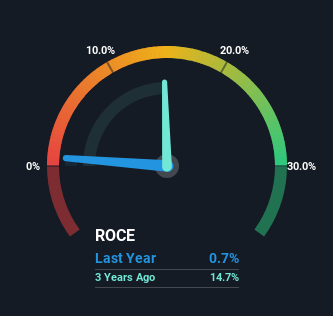- Portugal
- /
- Renewable Energy
- /
- ENXTLS:GVOLT
Greenvolt - Energias Renováveis (ELI:GVOLT) May Have Issues Allocating Its Capital

To find a multi-bagger stock, what are the underlying trends we should look for in a business? Firstly, we'll want to see a proven return on capital employed (ROCE) that is increasing, and secondly, an expanding base of capital employed. Put simply, these types of businesses are compounding machines, meaning they are continually reinvesting their earnings at ever-higher rates of return. However, after investigating Greenvolt - Energias Renováveis (ELI:GVOLT), we don't think it's current trends fit the mold of a multi-bagger.
Return On Capital Employed (ROCE): What Is It?
For those that aren't sure what ROCE is, it measures the amount of pre-tax profits a company can generate from the capital employed in its business. Analysts use this formula to calculate it for Greenvolt - Energias Renováveis:
Return on Capital Employed = Earnings Before Interest and Tax (EBIT) ÷ (Total Assets - Current Liabilities)
0.0074 = €13m ÷ (€2.0b - €306m) (Based on the trailing twelve months to September 2023).
Therefore, Greenvolt - Energias Renováveis has an ROCE of 0.7%. Ultimately, that's a low return and it under-performs the Renewable Energy industry average of 7.6%.
View our latest analysis for Greenvolt - Energias Renováveis

In the above chart we have measured Greenvolt - Energias Renováveis' prior ROCE against its prior performance, but the future is arguably more important. If you'd like, you can check out the forecasts from the analysts covering Greenvolt - Energias Renováveis here for free.
How Are Returns Trending?
When we looked at the ROCE trend at Greenvolt - Energias Renováveis, we didn't gain much confidence. To be more specific, ROCE has fallen from 14% over the last four years. Although, given both revenue and the amount of assets employed in the business have increased, it could suggest the company is investing in growth, and the extra capital has led to a short-term reduction in ROCE. And if the increased capital generates additional returns, the business, and thus shareholders, will benefit in the long run.
On a side note, Greenvolt - Energias Renováveis has done well to pay down its current liabilities to 15% of total assets. So we could link some of this to the decrease in ROCE. Effectively this means their suppliers or short-term creditors are funding less of the business, which reduces some elements of risk. Since the business is basically funding more of its operations with it's own money, you could argue this has made the business less efficient at generating ROCE.
The Bottom Line On Greenvolt - Energias Renováveis' ROCE
While returns have fallen for Greenvolt - Energias Renováveis in recent times, we're encouraged to see that sales are growing and that the business is reinvesting in its operations. These trends don't appear to have influenced returns though, because the total return from the stock has been mostly flat over the last year. As a result, we'd recommend researching this stock further to uncover what other fundamentals of the business can show us.
Greenvolt - Energias Renováveis does have some risks, we noticed 3 warning signs (and 1 which doesn't sit too well with us) we think you should know about.
If you want to search for solid companies with great earnings, check out this free list of companies with good balance sheets and impressive returns on equity.
If you're looking to trade Greenvolt - Energias Renováveis, open an account with the lowest-cost platform trusted by professionals, Interactive Brokers.
With clients in over 200 countries and territories, and access to 160 markets, IBKR lets you trade stocks, options, futures, forex, bonds and funds from a single integrated account.
Enjoy no hidden fees, no account minimums, and FX conversion rates as low as 0.03%, far better than what most brokers offer.
Sponsored ContentNew: Manage All Your Stock Portfolios in One Place
We've created the ultimate portfolio companion for stock investors, and it's free.
• Connect an unlimited number of Portfolios and see your total in one currency
• Be alerted to new Warning Signs or Risks via email or mobile
• Track the Fair Value of your stocks
Have feedback on this article? Concerned about the content? Get in touch with us directly. Alternatively, email editorial-team (at) simplywallst.com.
This article by Simply Wall St is general in nature. We provide commentary based on historical data and analyst forecasts only using an unbiased methodology and our articles are not intended to be financial advice. It does not constitute a recommendation to buy or sell any stock, and does not take account of your objectives, or your financial situation. We aim to bring you long-term focused analysis driven by fundamental data. Note that our analysis may not factor in the latest price-sensitive company announcements or qualitative material. Simply Wall St has no position in any stocks mentioned.
About ENXTLS:GVOLT
Greenvolt - Energias Renováveis
Operates in the renewable energy sector in Portugal, the United Kingdom, and internationally.
High growth potential slight.
Market Insights
Community Narratives



